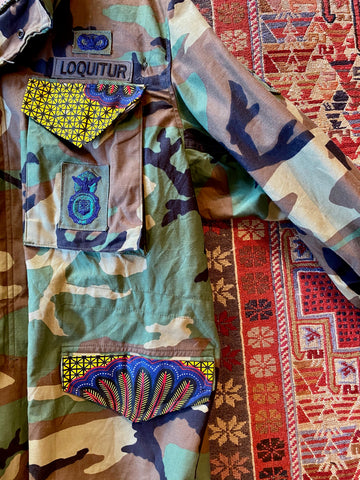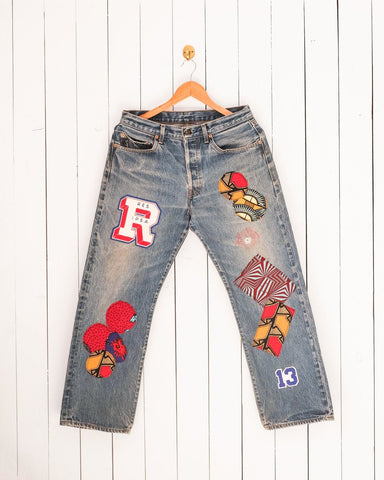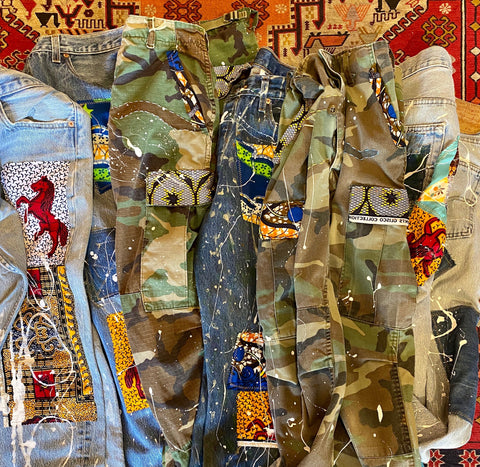Marrakech, Morocco — Our brand believes humans are hard-wired for narrative and that every product should have a story. Inspired by our travels to the great cities of the world, we love discovering the most interesting fabrics and then transforming them into something equally sustainable and cool. With the help from talented local artisans here in the US, in Istanbul, and at our atelier in Marrakech, we are continually able to expand our product offerings and collections to reach new global audiences.
From our signature men's and women's kilim shoes to our babouche 'boucherouite' slippers, we want to breathe life into Western culture by spreading the magic of these materials through our modern takes on traditional forms. West African Wax fabrics are the latest fabrics to join this journey of repurposing and repairing something old into something new and cool!
Read on to discover the meanings behind these beautiful fabrics and how we style their bold prints into our one-of-a-kind, ready-to-wear repurposed vintage 501 Denim, Patched Sweatshirts, and M-65 jacket collections.

What is West African Wax fabric?
Definition of West African Wax fabric
- West African Wax Fabric is commonly known as 'Ankara' or 'Dutch wax'
- Common clothing in Africa, especially West Africa
- Consistent, colorful intensity throughout the cotton fabric (front and back)
- Wax print fabrics are a type of non-verbal, visual communication among African women
- Originally influenced by the process of Batik-style printing, an Indonesian method of wax-resistant techniques for dyeing
Brief History of West African Wax fabric
- West African Wax fabrics originated in Indonesia and were brought to Africa in the 1800's through imports and replications of the batik process
- Batik is a protected process by UNESCO
- Deeply associated with African clothing
West African Wax Fabric Qualities & Hidden Meanings
- Handmade and printed on Batik cotton cloth (an Indonesian cloth)
- 100% cotton
- Typically one-of-a-kind although designs are replicated and associated with deeper meanings, motifs and popular symbols
- Designs are printed onto Batik cloth using wax before adding dyes (1-3 colors)
- Wax-resist dyeing and special machinery gives the fabric a unique crackling effect
- Wax-resist prevents the dyes from spreading throughout all the cloth using wax to create a pattern
- Sometimes the wax can be used as a stencil that is applied to the cloth before dyeing and this is known as resist printing
- Designs reflect local traditions and symbols
- Fabric is worn not just as sign of status but also for style
Each wax print fabric has a special meaning and tells a story. Many prints are associated to reflect West African traditions as well as local tribal patterns and motifs. Similarly to how weavers of kilim expressed their emotions through motifs and symbols woven into the rugs (traditionally, women wove kilim rugs), wax prints can often be used by African women as a form of non-verbal, visual communication.
Wax print fabric patterns may also be associated to reflect international culture and symbols. Many prints are global in their reach. In a 2018 Vogue article, the magazine detailed eight different prints and their unique stories from modern prints made for Queen Elizabeth II and Michelle Obama to traditional prints reflecting original interpretations and meanings behind prints and patterns.
 A sign of modernity, the electrical fan print sprung when electrical fans were introduced to Africa in the 1980's.
A sign of modernity, the electrical fan print sprung when electrical fans were introduced to Africa in the 1980's.

West African Wax Fabric and Res Ipsa
We are rapidly evolving to tell new stories and offer new products to our website that were previously only available in-store. Our latest releases include our repurposed vintage 501 denim. Each pair is a one-of-a-kind creation and are zero-waste. The vintage 501 Denim collection is available online and features repaired classic jeans with hand-stitching, paint splatter, and patched holes using deadstock fabrics like vintage American quilts, paint cloth and West African fabrics.




 Our repurposed vintage M-65 Jackets are available in-store only or via email info@resipsausa.com.
Our repurposed vintage M-65 Jackets are available in-store only or via email info@resipsausa.com.

---
#ResIpsa
#OurBrandisTravel




